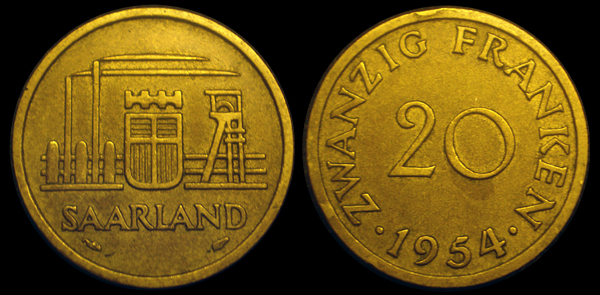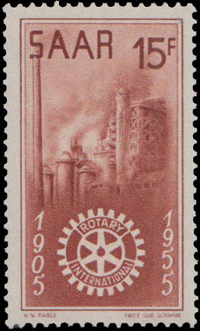
20 FRANKEN COIN - SAARLAND (Sarr Protectorate)
(KM 2)
Date: A.D. 1954
Obverse: Factory and mining tower with Saar Protectorate coat of arms in front / Text: SAARLAND
Reverse: Text - 20 ZWANZIG (twenty) FRANKEN 1954
Engraver: Theo Siegle
|
This coin was minted during a brief period following World War II when the industrial state of Saarland was governed as a protectorate of France and a member of the Council of Europe. The French franc was accepted currency in the Saar Protectorate as were the Saarland franken but the franken was not generally accepted as legal tender in France. Named for the Saar river that flows through the mineral rich region, the area that would become Saarland was first settled by Celtic tribes like the Treveri and Mediomatrici until it was taken by the Romans in the first century BC and became a part of the province of Belgica. It was then occupied in the 5th century by the Franks and was eventually divided between several local semi-independent rulers within the Holy Roman Empire, most notably the Counts of Nassau-Saarbrucken. During the 17th and 18th century, French monarchs began invading the territory looking to exploit the wealth of natural resources in the region until it was finally conquered in 1792 and made a part of the French Republic. The French would lose the region after the defeat of Napoleon in 1815 and it would again be sectioned up, this time between the Kingdoms of Prussia and Bavaria with a smaller part going to the Dukes of Oldenburg. Under Napoleon III France would again attempt to take the valuable region which would signal the beginning of the Franco-Prussian war. As a result the territory would become a part of the new German Empire. The area of the Saar basin was occupied after World War I by the British and French who sought to recoup war losses by capitalizing on the region's wealth of raw materials and its thriving coal, iron and steel industries. According to a 1920 mandate by the League of Nations, the region would be administered by France for 15 years. After the 15 year French rule, a plebiscite was held and roughly 90% of the majority German territory voted to rejoin Germany in 1935. After World War II and the collapse of the German state, the region was again occupied and administered by France becoming the Saar Protectorate. While the protectorate was administered by French military governors for all of its history, a local regional administration was created and headed by leaders from the mostly German citizens. France and the Federal Republic of Germany developed and agreed to a plan called the Saarstatut which mandated the creation of an independent Saarland in 1954, but a plebiscite held in 1955 rejected this plan by showing that almost 70% of the mostly German citizens of Saarland preferred to instead rejoin Germany. The Saar Treaty was enacted on October 27, 1956 allowing Saarland to join the Federal Republic of Germany. It was reunified with Germany on January 1, 1957 with its largest city Saarbrucken as its capital. The reunification of Saarland with Germany was the last major change to European borders until the collapse of the Soviet Union 30 years later. Saarland the one of the smallest German states after the city state of Berlin, and the states of Bremen and Hamburg. |



